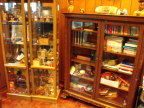
The puzzles displayed
To clear the room for the floor refinishers, I had to pack my puzzle collection. So I decided my heirs should begin to inherit. The puzzles go to Bex to share with her children and their cousins. And you get to see them here.  Packed puzzles
The puzzles are packed in half-a-score boxes with numbers and dates. But they should be opened one puzzle at a time. I packed a few extra toys—not puzzles; be wary, if it's in a box and not in the catalog, maybe it's not a puzzle.
Rules for puzzles
- Do not force a puzzle. It will break.
- Have a place to store each puzzle. Before going to bed be sure each puzzle lies comfortably in its place.
- When doing puzzles with multiple pieces, spread a blanket to catch any drops.
- Take care in choosing when to open a new puzzle. One a month is plenty.
- If you solve a puzzle, put it away.
- If you have not solved a puzzle, put it away. Wrap it first if it has multiple pieces.
- It is not necessary to solve a puzzle. It will not mind. It prefers that you enjoy it.
- Do not force a puzzle. It will break.
Enjoying Puzzles
Why do we like puzzles? Many reasons.
Sometimes we do a puzzle for the challenge posed by someone else, either difficult or tricky.
These are not the same. A difficult puzzle can take a long time to solve even if you know how. A tricky puzzle, the more interesting of the two, takes little time to solve when you know how.
Difficulty does not equal enjoyability. A puzzle may be easy and fun or hard and not very interesting. For the present collection, the correlation between the two is -.22. Since the value is negative, it is the case that a harder puzzle tends to be less iteresting.
Sometimes we fiddle with puzzles for the sheer tactile joy of feeling and moving them. Or looking at the shapes they make. Enjoyable puzzles may be hard or soft, rounded or angular, shiny or dull, wood, metal, glass, or (sometimes) plastic.
Sometimes I show another person, an ordinarily-non-puzzle person, how to do a tricky puzzle. And then have the fun of watching that person amaze others by doing the puzzle in hiding while clever colleagues cannot. I showed our office receptionist how to do the two horseshoes and she had a wonderful time stymying the programmers.
Categories
The more categories you have, the fewer puzzles in each, but the harder it becomes to choose a category for each puzzle. Puzzle World offers a great discussion of categories which I have followed in my catalog. Briefly (with links to the Puzzle World site) the categories I have used are these: 
Four cubes in a box
- Put-Together A picture puzzle is a 2-dimensional (2D)put-together puzzle, but few are in my collection. They are time-consuming, but not particularly tricky or interesting. I have many 3D put-together puzzles. One of the simplest and best is simply four blocks to be inserted in a box. Why is it even a puzzle? Because no pair of edges meet at exactly aright angle. Indeed, all the angles differ.
 Trapped sparkplug - Interlocking puzzles are three dimensional and made of two or more pieces that slip apart and back together. The elephant, the logo above, is one such puzzle. Others like the six-piece burr are more complex and also require dexterity.
 Six-piece burr
- Disentanglement puzzles have usually a main body and another piece to be gotten off. In some cases, like ring, post and rope, the main body has a flexible part (the rope). Another classic variety is made of metal wire like the pair of 5 U's. The thicker the wire the more satisfying it is to play with these.
- Sequential Movement puzzles are maze-like. The goal is to move a tile or ball through a collection of obstacles. Two dimensional versions like slide-out-the-bottom usually require moving other pieces in order to make way for the target object.
 Rubik's cube
Rating Scales
I have arbitrarily rated the puzzles on two scales, enjoyability and difficulty. Here they are:
Enjoy puzzling!
|










